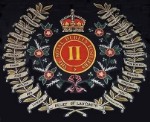The British Army Reference for Ulysses Scholars
Online Supplement for Volume I of The British Army on Bloomsday
Addenda and Errata
p. 142, fn. 76. Add the following:
Unlike in previous wars, war-service enlistments into the Regular Army were offered sparingly. The army "specially raised" only 3,286 men, all specialists whose civilian careers made them deployable after brief army training. Recruited for one-year terms with the regulars were pharmacists, hospital attendants, physicians and surgeons for the RAMC, artificers for the Royal Artillery, telegraphists for the Royal Engineers, postal sorters for the Post Office Corps, and clerks for the ASC. Appendices, South Africa Report, No. 13.
p. 291. "Accordingly, after general mobilization, nearly all militia units were at half strength with many militiamen too young, or insufficiently trained, for effective military service." Insert the following footnote:
n/ At the start of hostilities, War Office policy prohibited deployment to South Africa of soldiers under the age of 19. Because so many militiamen enlisted at age 17 or 18, the minimum age for their deployment was lowered to 18. Had this modification not been implemented, no militia battalion would have had enough deployable troops to qualify for South African service. Testimony of MG Herbert C. Borrett, Inspector-General of Recruiting, Minutes of Evidence, Vol. I, Royal Commission on the War in South Africa, 1908 [Cd. 1790], at q. 5255.
p. 317, fn 21. After the citation to Spiers, change to read as follows:
For 1909, the War Office claimed that 29% of recruits met or exceeded the educational standard for 10-year-olds. Educational attainment varied widely by corps. For the Ordnance Corps, 25.2% of recruits had complete, primary schooling (Standard VII); RAMC 22.6%, Royal Engineers 12.0%. The line infantry regiments had the least educated recruits; only 3.8% were at Educational Standard VII. Annual Army Report, 1909, 1910, [Cd. 5016].
I. The Army Camp at "The Curragh"
During the Late-Victorian and Edwardian years, Curragh Camp was one of the British Army's principal training centers, and the only large military facility in Ireland. Of the army's four training camps (Curragh, Aldershot, Shorncliffe, and Colchester), the Curragh was the second largest.
In 1904, the camp was a town with its own post office, civilian shops, churches, and recreation facilities. During that year, the uniformed strength at the camp averaged 3,413.
n/ War Office, Army Medical Department Report for 1904, 1906, [Cd. 2700].
The Census of Ireland for 1901, which took place during the Second Boer war, shows 3,277 males and 980 females (total 4,257) resident at the camp. In the peace-time years of 1891 and 1911, the total population was 5,290 and 6,163, respectively. In 1911, 1,150 females resided at the army facility, 18.7% of the total population. That year, there were two regimental schools in Newbridge, one in Kildare, and three in the camp. The Kildare and Curragh schools, combined, had an enrollment of 162 boys and 185 girls. In the census records, the camp appears under the enumerations for the District Electoral Division of Ballysax East, Co. Kildare, Leinster County Books.
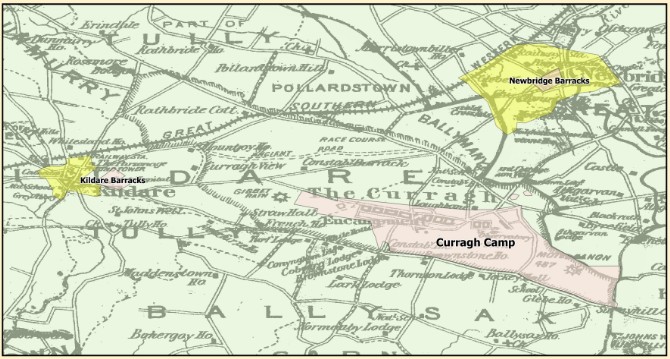
Richards Memorial Atlas of Ireland, 1901, Cincinnati Public Library.
History
The Curragh Camp was completed in 1855 as a temporary facility to train recruits required by the army for the Crimean War. It was built in four months and construction employed 2,000 workers. The War Office retained the facility through the Indian Mutiny and after cessation of hostilities, decided to make it a permanent, all-arms training site. In 1861, Parliament authorized expenditure of £192,822 for improvements to Curragh Camp sought by the War Office.
During the 1860s, the permanent garrison grew and a great number of regiments trained there annually. Economic and social relationships between army personnel and nearby civilians, primarily merchants and farmers, strengthened. As throughout Ireland, officers stationed at the Curragh were welcomed by the local Anglo-Irish, landed elite who shared their backgrounds, interests, and social status.
As Curragh camp housed several thousand, unmarried, young soldiers, prostitution soon flourished. The most notorious of the prostitutes were known as "The Wrens of the Curragh." The Wrens were destitute women who lived in makeshift shelters on the Curragh Plain termed "nests." The nests were made of sod, lacked fireplaces, and were practically unfurnished. The Wrens lived communally, pooling their earnings and sharing childcare responsibilities. James Greenwood, an English social reformer, journalist, and author, visited the Curragh in 1867 to investigate "mysterious little stories" of "a colony of poor wretches" living on the plain. His written findings were published by the Pall Mall Gazette in October 1867 as a feature article in four installments. Before year's end, his article, with an introduction, was published as a pamphlet: The Wren of the Curragh (London: Tinsley Bros., 1867). (Click on the link to go to the Google Books page from which you can download the pamphlet. The page will open in a new browser window.)
In the 1890s, a massive construction program was undertaken by the War Office to upgrade the camp's infrastructure. Of primary importance to the troops was the replacement of antiquated, wooden barrack buildings with new brick structures and construction of modern family housing.
n/ Dan Harvey, Soldiers of the Short Grass (Sallins, Ireland: Merrion, 2016).
In 1922, the new Irish Free State retained Curragh Camp for its army and in 2020 the camp was one of two major training facilities of the Irish Defence Forces. The Curragh is no longer home to any large combat formations but the 1st Mechanized Infantry Company, 1st Armoured Cavalry Squadron, and special forces Ranger Wing are quartered there. The three units combined have 500-600 combat troops.
Military Establishment on Bloomsday
Click on the above link to download from Major Tweedy's Neighborhood a listing of the army formations at Curragh Camp, Kildare Barracks, and Newbridge Barracks on Bloomsday. It's in the file Units_CurraghCamp.pdf (121 kb) that will open in a new browser window.
Curragh Camp, like all British Army posts, had a permanent staff whose jobs were to maintain the physical plant and provide support to hosted army formations. Many of the permanent staff were civilians, mostly former soldiers. The largest contingent of personnel consisted of the military formations stationed there. The senior commanding officer among the tenant units would be the post commander.
In 1904, three formation headquarters were located at the Curragh: 7th Division, 14th Brigade, and 3rd Cavalry Brigade. The staff of the 7th Division was also the staff of the Dublin Military District. The officer commanding 7th Division was also the officer commanding 14th Brigade. If the 7th Division was mobilized, then the War Office would appoint a brigadier to command 14th Brigade. The 14th Brigade was subordinate to the 7th Division but the 3rd Cavalry Brigade was subordinate directly to Irish Command (which would provide the staff for III Corps). The other brigade of 7th Division was the 13th Brigade, the Dublin Garrison. Note that one of 3rd Cavalry Brigade's regiments was stationed in Dublin at Marlborough Barracks. It's other two regiments were at the Curragh and its horse artillery component was quartered in Newbridge Barracks. The 3rd Cavalry Brigade gained notoriety in March 1914 when most of its officers "mutinied." See the link to the Curragh Mutiny, below.
Click on the above link to download from Major Tweedy's Neighborhood a listing of senior staff at Curragh Camp on Bloomsday. It's in the file Staff_CurraghCamp.pdf (133 kb) which will open in a new browser window.
Camp Plan, c. 1904

Download Camp Plan from Major Tweedy's Neighborhood
Note that the 6" Ordnance Survey of Ireland maps for the towns of Kildare and Newbridge were digitized by amateurs and accordingly, are not of the quality you would get with purchased digital images. The county background tiff file is of high quality and was digitized by the Cincinnati Public Library.
High resolution images imbedded in Curragh_Images. pdf (8.0 MB). The file will open in a new browser window.
Vector files and georeferenced tiff files of Ordnance Survey of Ireland maps and Richards Memorial Atlas of Ireland. Compressed into the file Curragh_Shape.zip (12.2 MB).
Curragh Camp - Irish Defence Forces
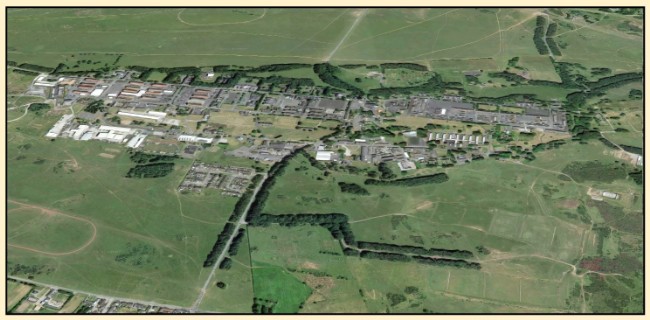
© 2021 Google, Maxar Technologies
Links to Other Websites
Note: Webpages, other than those for the NLI photographs, will open in new windows.
Click on the link to go to that page of the website. Click on the icon to go to the website's home page.
From The Curragh, a website on The Curragh of County Kildare created by Matt McNamara. This page is a transcription by Sue Rowbotham from the pamphlet Curragh Camp and District. Illustrated and Described (Dublin: Eason, c. 1910).
Article by Diarmaid Ferriter published in the Irish Times on the 100th anniversary of the incident.
Article by Con Costello on the history of the camp from 1854 to 1922. History Ireland 6, No. 3 (Autumn 1998).
Photographs of the Curragh Camp
These links will take you to digitized photo pages on the website of the National Library of Ireland ("NLI"). The photographs are from the Eason and Lawrence Collections. The Eason photographs were taken between 1900 and 1920; Lawrence photographs 1865 and 1914. These digitized images are property of the NLI. See the library's terms of use if you wish to use any of these files in a website, print publication, or ebook.
Note: The NLI webpages will open in popup windows.
II. The Irish Military Department and Establishment
(The British Army in Ireland Prior to Union)
During the eighteenth century, the British Army operated in Ireland pursuant to a legal fiction that the Kingdom of Ireland maintained its own military establishment. The legal basis for Irish maintenance of foreign troops in Ireland was the English Disbanding Act of 1699. It required the King (of Ireland, Scotland, and England) to maintain in Ireland an army of at least 12,000 men "at the sole charge of the said Kingdom of Ireland."
n/ 10 Will. 3, c. 1.
The British Army in Ireland had two components, the overwhelmingly native, civilian Irish Military Department and the overwhelmingly foreign, uniformed Irish Military Establishment.
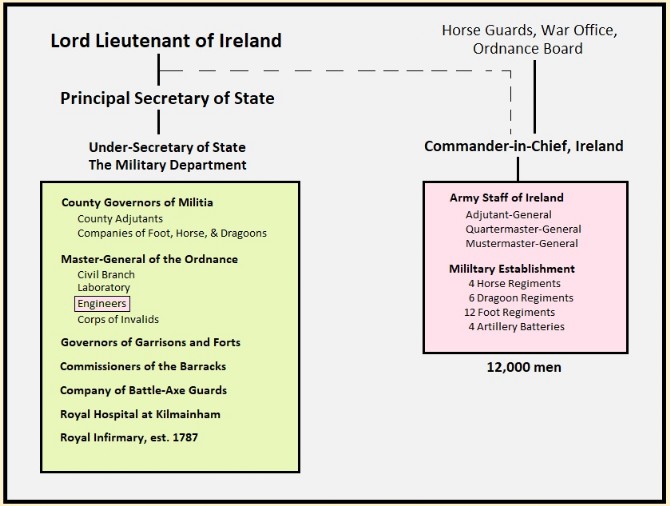
Sources: Stephen Ferguson, "The Army in Ireland from the Restoration to Act of Union," PhD Thesis, Trinity College (Dublin) 1980; Watson's Gentleman's and Citizen's Almanack, 1772; Treasury, Public Income and Expenditure, 1688-1869, 1868-69, H.C. Accounts & Papers, Nos. 366, 366-I; 9 Journals of the House of Commons of the Kingdom of Ireland (1756), 874.
The Military Department was one of the three arms of executive power in Ireland. The other two were the Civil Department and the Ecclesiastical Department, which was simply the Church of Ireland. The two secular departments were headed by under-secretaries of state appointed by Westminster, while the established church's chief executive was the Archbishop of Armagh who also had the title "Primate of the Church of Ireland." Note that in 1708, Union was effected between England and Scotland and the "triple crown" of the British Isles became a "dual crown."
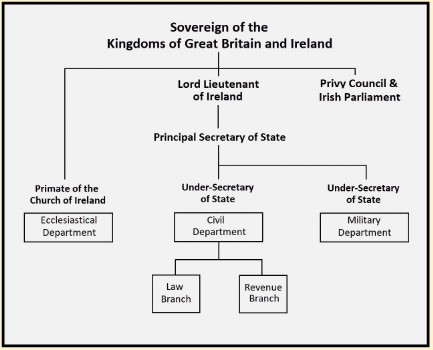
The Military Department
The Militia
From 1716 to 1778, the Irish Militia consisted of individual mounted and foot companies paid for by local property taxes. This auxiliary force was composed of Protestants only and Catholics paid taxes at twice the rate charged Protestants. Militiamen trained four days annually. The Militia Act of 1778 reconstituted the Militia as a force composed entirely of foot companies and made funding a national, Parliamentary responsibility. Required training was increased to an annual muster not to exceed 28 days, plus up to 2 days drill each month. The Militia Act of 1793 opened the force to Catholics and provided for a standing regimental organization of 38 battalions/regiments of foot.
In each county, the Militia was headed by a civilian with the title of Governor. His principal subordinate was a full-time, militia officer (County Adjutant), who oversaw day-to-day management of the force.
n/ 2 Geo. 1 (Ireland), c. 9; 17 & 18 Geo. 3 (Ireland), c. 13; 33 Geo. 3 (Ireland), cc. 21, 22.
Total militia strength varied greatly throughout the eighteenth century from a low of about 10,000 when it was reorganized in 1778, to a high of 45,000 in 1756. Authorized strength in 1793 was 17,000 men, all ranks.
The Ordnance of Ireland
This establishment was responsible for army stores, construction and maintenance of fortifications, weapons for the Irish Military Establishment and Militia, supervision of Royal Engineers stationed in Ireland, and until 1797, the provision of food to the army. Until that year it was also the army's transportation service in Ireland. Except for the Royal Engineers, all work was performed by civilian employees and contracted firms. The Ordnance was headed by a civilian with the title Master-General of the Ordnance. The Ordnance's "laboratory" manufactured gunpowder and the Corps of Invalids were veterans employed as caretakers of forts and castles.
n/ Ferguson, "The Army in Ireland;" Watson's Gentleman's and Citizen's Almanack, 1772.
Barracks
Barrack construction and maintenance were the responsibility of the Commissioners of the Barracks who also served as Commissioners of Public Works in the Civil Department. The commission had a headquarters staff of eight civilians supervised by a Quartermaster-General and Deputy Quartermaster-General, both of whom were British Army officers. Contracting for repairs and supervision of full-time workmen was the responsibility of about twenty-five civilians with the position of "barrackmaster." Each barrackmaster was responsible for repairs at one to six barracks.
n/ Ibid.
To download from Major Tweedy's Neighborhood a list of barrack accommodation in 1759 click on the following link. The list is in the file BarracksList_1759.pdf (329 kb) which will open in a new browser window.
The barracks in Ireland were notorious for their poor condition and ill-effect on the health of resident troops. The public assumed this was the fault of the barrackmasters.
Anonymous, 2nd Ed. (London: A. Moore, 1767). This booklet was published by the barrackmasters as a rebuttal to public charges of incompetence and corruption. The poor state of the barracks was blamed on the miserly Parliamentary appropriation for their upkeep. Download from Google Books. Click on the above link or icon and the book's webpage will open in a new browser window.
A project to identify and research barracks in 18th Century Ireland by researchers based at University College Dublin. The principal investigator is Professor Ivar McGrath, School of History, UCD. Click on the link above and the interactive map will open in a new browser window. Click on the icon to the right for the webpage of the School of History.
"Click the 'Layers' tab in the upper left to select the layer/s you wish to view. The 'All Barracks' layer is displayed by default. Other map layers (e.g. '1720, GEO1720') display barracks listed in a particular source. Each source provides details of barracks active at a particular point in time (i.e. Source Year). Each source is identified by a Source ID (e.g. GEO1720). The basemap can be changed to satellite imagery by clicking the toggle button at the top right of the map screen." For detailed instruction from UCD on the use of the map click here. The instructions will appear in a new browser window.
Prof. McGrath describes the map website and research project in a 19 minute podcast on History Hub. Click here and the History Hub page with the podcast will open in a new browser window. History Hub is a website of the Department of History, UCD. Click on the icon to the right and its home page will open in a new browser window.
Castles, Forts, and Town Garrisons
Every castle, fort, and important garrison town had a small permanent staff responsible for state security (apprehension of spies, suppression of sedition) and operation of the garrison (upkeep of departmental facilities, posting of sentries, movement and quartering of troops.) The officer-in-charge held the title of "Governor" or "Constable of the Castle." Such positions were often sinecures and the actual work was done by the Town Major or Fort Major.
In Dublin, the largest garrison city in Ireland, the work of the permanent staff was in the remit of the Town Major and not the Constable of Dublin Castle (whose rank was equivalent to governor). Military Department facilities in Dublin were Royal Barracks (the largest in Europe), the Magazine Fort, Dublin Castle, and The Royal Hospital for Pensioners in Kilmainham. At the end of the eighteenth century, a medical hospital for the Irish Military Establishment opened in Ireland: The Royal Infirmary.
The positions of Town Major and Fort Major were civil, though the office-holder was frequently a half-pay or former regular army officer, or held a commission in the auxiliary forces. Town and Fort Majors were rank-equivalent to the last Regular Army rank they held. If they had no prior army service they were ranked as the junior captain of the garrison. Henry Charles Sirr, mentioned in Ulysses, was a former lieutenant in the 68th Regiment of Foot who while he served as Town Major of Dublin was a first lieutenant of the Stephen's Green Yeomanry, Dublin City Volunteers.
n/ Army List, 1766; U (Gabler) 10:785-86; Dublin Gazette, October 25 to 27, 1796; London Gazette, May 13 to 16, 1780, September 27 to October 1, 1791; General Regulations for His Majesty's Army in Ireland, 1794.
Facilities of the Irish Military Department

Sources: Ferguson, "The Army in Ireland;" Watson's Gentleman's and Citizen's Almanack, 1772.
Company of Battle-Axe Guards
Formed in 1684 by Charles II it was a ceremonial guard modeled on the English Yeomen of the Guard. It consisted of a Captain of the Guard, two Lieutenants, two Sergeants, and fifty Yeomen. The Captain, upon appointment, received from the British Army an extra-regimental commission as colonel; the Lieutenants were commissioned as captains.
The first officer appointments were purchased from the state; afterwards, new officers purchased their appointments from the incumbents. The captaincy sold for £9,700, lieutenancies for about £2,000. Sergeants purchased their appointments from the Captain and paid £500; Yeomen paid £137 to the Captain plus £5 to each Sergeant.
All members of the company received lodging at Dublin Castle plus either meals or a meal allowance. They received new uniforms every 18 to 24 months. Annual salaries were as follows:
Captain of the Guard £447
Lieutenant of the Guard 346
Sergeant .£110
Yeoman 20
For Yeomen, the position was not a full-time job as the routine, daily complement of guards was twelve, indicating about two days of guard service each week. For state ceremonies there was additional duty. Positions in the Company were more honorable than lucrative. In 1832, the British government disbanded the Company.
n/ Samuel Pegge, Curialia, Part III (London: Society of Antiquaries, 1791); Reginald Hennell, The King's Body Guard of the Yeomen of the Guard (London: Constable, 1904); Army List, 1766.
Royal Kilmainham Hospital
The Royal Hospital at Kilmainham was built at the request of King Charles II as a residence for infirm, pensioned soldiers of Irish birth. It was modeled on Les Invalides in Paris and completed in 1684. A similar facility in London, the Royal Hospital at Chelsea, opened in 1686. The hospital staff not only cared for resident "in-pensioners" but made payments to army "out-pensioners" living on their own in Ireland.
The nominal head of the hospital, the Master of the Hospital, was the Commander-in-Chief, Ireland, who was quartered there and had his offices on hospital grounds. Day-to-day management was in the hands of the Deputy Master, an army officer on half-pay. In 1772, subordinate to the Deputy Master was a senior staff of nine; physician, surgeon, apothecary, chaplain, scripture reader, registrar, paymaster, chamber-keeper, and register clerk.
n/Watson's Gentleman's and Citizen's Almanack, 1772.
During the eighteenth century, the hospital usually had 400 residents. In 1726, there were 570 out-pensioners. The number of out-pensioners increased progressively during the century until 1785 when they plateaued at about 2,500.
n/ Ferguson, "The Army in Ireland," 94.
Muster Office
This civilian office was responsible for the proper outlay of public money to the Military Establishment. It also prepared monthly returns of regimental strength. The officer in charge of this establishment held the title Mustermaster-General.
n/ Ibid., 17, 33, 64.
The Royal Infirmary
A general hospital opened in 1787 for soldiers of the Irish Military Establishment. It was located in the southeast corner of Phoenix Park near Park Gate Street. After Union, it became a hospital of the British Army. In 1799, the officers of the infirmary were two surgeons, a chaplain, an apothecary, a steward, and a storekeeper.
n/Watson's Gentleman's and Citizen's Almanack, 1800.
Medical Board
In 1795, Westminster placed the responsibility of providing surgeons for the Irish Establishment upon the Kingdom of Ireland. Previously, the British Army Medical Board commissioned surgeons for service in Ireland. The board consisted of three commissioners. It's chief executive was the Director-General of Military Hospitals.
n/ Ibid.
Commissariat of Ireland
In 1797, the responsibility for providing the army in Ireland with food and transportation was removed from the Ordnance and placed into a new establishment of the British Army, the Field Train. The initial establishment was 150 horses and 300 men, taken from mounted regiments in Ireland. By the end of 1798, this unit had a strength of 850 drivers and 1700 horses. The Field Train purchased provisions that were laid in at selected places, and eighty civilians were employed as storekeepers and laborers. By the time of Union, it had been renamed the Commissariat of Ireland and had become a component of the Military Department. The Commissariat was composed nearly entirely of civilians; however, it was headed by a colonel of the British Army who held the office of Commissary-General.
n/ Ferguson, "The Army in Ireland."
The Military Establishment
Throughout its history, the Military Establishment was never an Irish Army. In the early part of the eighteenth century, the King had sole control of the army in Ireland. Later, that power was limited by the British Parliament. In 1782, Westminster granted the Irish Parliament independence but did not give that body much authority over the Military Establishment. Throughout its existence, the nominally Irish force was controlled by the Lord Lieutenant and the Commander-in-Chief in Ireland; two men whose constitutional responsibility was to the King and the British Parliament.
n/ G.J. Hand, "The Constitutional Position of the Irish Military Establishment," Irish Jurist 3 New Series, No.2 (Winter 1968):330-35.
Up until the end of the seventeenth century, the Lord Lieutenant of Ireland was also commander of all English forces on the island. In 1689 that changed, at least in form, when Westminster created the position of Commander-in-Chief, Ireland. In the eighteenth century the Lord Lieutenancy had become a political, civil position and tension developed between the Viceroy and Commander-in-Chief as to who had ultimate, local authority over the Irish Military Establishment. When incompatible positions were taken by the two parties, the Castle generally prevailed.
n/ Ferguson, "The Army in Ireland," 65-66.
The Irish Military Establishment consisted not only of British Army units stationed in Ireland but also several regiments stationed abroad. For example, at the end of 1771, three regiments were in Gibraltar, one in the West Indies, and one in Great Britain.
n/ Watson's Gentleman's and Citizen's Almanack, 1772.
It wasn't until 1871 that army officers became entitled to pensions and the War Office placed age limitations on serving officers. Until then, officers who wished to retire but did not want to sell their commissions, went on reserve status which was known as the half-pay list. Some officers on the list weren't retired but simply on hiatus from full-time service. A good number of half-pay officers were on the Irish Establishment. In 1767, these officers numbered 671. Officers on the list were not paid at half the rate for serving officers, but pursuant to a half-pay schedule. For the Irish Establishment, annual half-pay ranged from £36 for infantry quartermasters to £347 for colonels of horse. Captains of foot received £87 while those of horse £155. Irish half-pay was usually somewhat lower than British half-pay. For example, a half-pay captain of foot on the British Establishment received £91 per annum.
n/ Army List, 1767; Ferguson, "The Army in Ireland."
The usual complement of full-strength regiments on the Irish Establishment was four of horse, six of dragoons (mounted infantry), and twelve of foot. Total strength, all ranks, rarely dipped below the statutory minimum of 12,000. Often the regiments in Ireland were at half-strength or less. For example, in 1752, a year of peace, there were on the island four regiments of horse, six regiments of dragoons, and twenty-four regiments of foot. The foot regiments were maintained at 46% of authorized strength, the horse 50%, and the dragoons 60%. Total regimental strength that year, all ranks, was 11,226. Four years later; however, the regiments of foot were at full strength and numbered only twelve.
n/ The Quarters of the Army in Ireland in 1752; Mustermaster-General, An Account of the Forces of this Kingdom on 29 March 1756, 9 Journals of the H.C. of the Kingdom of Ireland, 874-75.
In 1766, the year the global Seven Years War concluded, there were stationed in Ireland four regiments of horse, eight of dragoons, twenty-four of foot, plus four batteries of artillery. During time of war, the Kingdom of Ireland was charged by Westminster to raise and fund additional regiments. Of the thirty-six regiments in Ireland in 1766, eight were raised specifically for the war.
n/ Army List, 1766.
Mounted Regiments
For most of the eighteenth century, mounted regiments (dragoons and horse) on the Irish Establishment were quite small and had an authorized strength of fewer than 250 men, all ranks. In most years, such regiments had fewer than 200 men. Compared to foot regiments, mounted regiments were top-heavy in officers. Combatant officers made up almost 7% of total strength; other officers about 5%. In regiments of foot, combatant officers were 3.7% of total strength; other officers 0.6%. Each regiment received as a contingency, pay and subsistence money for 24 men termed "warrant-men." This extra money was rarely used to expand the regimental roll.
A regiment of horse (cavalry) had an authorized strength of 232 men, all ranks, organized in 6 troops. It had 15 combatant officers, 12 other officers (chaplain, surgeon, adjutant, quartermasters), and 205 men holding enlisted ranks. Of the other officers, 9 were quartermasters who were occupied mostly with purchase of horses, their forage, and services for their care.
A regiment of dragoons (mounted infantry) had an authorized strength of 216 men, all ranks, organized in 6 troops. It had 15 combatant officers, 12 other officers, and 189 enlisted men.
Regiments of Foot
A regiment of foot (infantry) on the Irish Establishment had an authorized strength of 817 men, all ranks, organized in 10 companies, one of which was designated "grenadier" and another "light infantry." The regiment had 30 combatant officers, 5 other officers, and 782 enlisted men. In many years, such regiments were at less than half-strength. Each regiment received funds for 40 warrant-men and like in a mounted regiment, such men were rarely recruited.
The Royal Irish Artillery
The artillery in Ireland was created by Westminster in 1756 as the Artillery Company of Ireland. The formation was expanded greatly and in 1758 was renamed the Regiment of Royal Irish Artillery and organized in four companies. A year later, the regiment had grown to six companies, but by 1789 was back to its 1758 establishment. During the war years at the close of the eighteenth century, the regiment reached its peak strength of 2,079 men, all ranks, organized in 20 companies. At the time of Union, the regiment consisted of 10 companies, all of which were absorbed into the Royal Artillery of the British Army.
In 1759, the artillery had an authorized strength of 610 men, all ranks, organized in 6 companies. It had 26 combatant officers, 6 other officers, and 578 men holding other ranks. It received no funds for warrant-men and was at or near authorized strength.
n/ John Moore, Army States for the Irish Establishment (Dublin: Marchbank, 1759); Ferguson, "The Army in Ireland;" Francis Duncan, History of the Royal Regiment of Artillery, Vol. I (London: Murray, 1872), 160-68.
Issued 1794 by the "Lord Lieutenant General and Governor of Ireland." On the website of Hathi Trust. Click on the above link or icon on the right and the book's webpage will open in a new browser window.
British Army Cost to Ireland
For the two years ended March 31, 1753 charges for the Military Department and Establishment together accounted for 72% of the Kingdom of Ireland's state expenses. For that same two-year period, civil administration accounted for 20% of expenses, civil pensions (mostly royal gifts) 7%, and interest on debt 1%. During those two, peace-time years, the Irish Military Establishment's strength was about 11,200 men in Ireland and another 800 abroad.
Annual Expenditure (Irish Pounds), 1751 & 1752
Military Department | Military Establishment | |||
Militia | Local Taxes | Effective Establishment | 320,000 | |
Ordnance | 5,300 | Half-Pay Officers | 10,000 | |
Barracks | 27,800 | Widows of Officers | 5,500 | |
Town Garrisons | 3,300 | Enlisted Pensioners (1,500) | 22,000 | |
Battle-Axe Guards | 1,600 | |||
All Other | 1,800 | |||
Total | 39,800 | Total | 357,500 |
In each of the subject two years, nearly £400,000 of Irish revenues were allocated to military spending. The regimental establishment and staff accounted for about 80% of military expenditure; pensions about 10% and support expenditure by the Military Department 10%. Note that enlisted pension expense is an estimate.
n/ Comptroller and Accountant-General, A State of the Establishment and Other Charges of Government for Two Years Ending March 1753, 9 Journals of the H.C. of the Kingdom of Ireland, 33-36.
[ You are at www.majortweedy.com>British Army on Bloomsday, Vol. 1>Supplement ]
